Plant of the Month: November 2010
|
| Sweet Potatoes in Seattle |
| Ipomœa Batatas (L.) Lam. |
CONVOLVULACEÆ; Bindweed Family
|
| During 2010, I tried to grow sweet potatoes in Seattle. That is a bit like trying to keep fish out of water. This article details my approach and findings. Briefly summarized: I learned that cultivars vary immensely, and that growing sweet potato plants for their edible leaves is well worthwhile; but for their swollen roots alone, I found them not worth space in a garden here. |
The sweet potato is well known as a crop adapted to, and thriving in, warm and hot places. It is easy to grow there. Gardening books assign it USDA climate zones 9 through 12. In terms of its cultural preferences, it has little in common with its unrelated namesake the common potato Solanum tuberosum L. The latter is in another plant family (Nightshade), requires little summer warmth, and its leaves are poisonous even cooked. A nutrient comparison of the common or Irish potato, and the sweet potato, reveals that compared to common potatoes, sweet potatoes are higher in fat, lower in protein; higher in minerals; way higher in vitamin A.
|
Globally, the world's food crops rank about as follows, in millions of metric tons per year:
|
|
|
|
| ranking |
Common Name |
mill. m. tons yearly |
| 1 |
sugar cane |
1,273-1,324 |
| 2 |
maize or corn |
630-792 |
| 3 |
wheat |
568-627 |
| 4 |
rice |
579-659 |
| 5 |
potato |
316-328 |
| 6 |
sugar beet |
242-249 |
| 7 |
cassava |
184-203 |
| 8 |
soybean |
168-204 |
| 9 |
barley |
138 |
| 10 |
sweet potato |
136 |
|
About 650 species of Ipomœa exist, in tropical and warm-temperate regions. The common sweet potato, Ipomœa Batatas, originated in central America. Domestication occurred before 6,500 years ago. It is hexaploid, and likely derived from the diploid I. trifida (HBK) G.Don, and is now grown globally wherever the climate permits. It is especially prized in China. The specific name batatas or batata dates from the 1500s --the Spanish name patata, from Carib [Haiti] batata, (sweet potato). After the first voyage of Columbus in 1492, sweet potato was introduced to Europe.
|
Cultivars of Ipomœa Batatas have been selected and grown for 3 main reasons:
|
1) edible swollen roots (the main role; Stephen Facciola's book Cornucopia II (1998) catalogs 9 "dry flesh" cultivars and 16 "moist flesh" ones in commerce; their color can be white, yellow, orange or purple);
|
2) edible leaves (rich in protein; "sweet potato spinach");
|
3) ornamental foliage --cultivars grown as summer annuals, such as Black Heart (= Ace of Spades = Purple Heart), Blackie, Chillin Blackberry Heart, Emerald Splash, Freckles, Gold Finger, Illusion Emerald Lace, Illusion Midnight Lace, Ivory Jewel, Lady Fingers, Margarita (= Sulfur = Chartreuse), Purple Tuber, Sidekick Black, Sidekick Lime, Sweet Caroline Bewitched Purple, Sweet Caroline Bronze, Sweet Caroline Green, Sweet Caroline Green Yellow, Sweet Caroline Light Green, Sweet Caroline Purple, Sweet Georgia Heart Purple, Sweet Caroline Red, Sweet Caroline Sweetheart Light Green, Sweet Caroline Sweetheart Red, Terrace Lime, Tricolor (Pink Frost). Some of these 26 cultivars have trademarked names and are patented.
|
| Some other Ipomœa species are prized as floral ornaments (morning glories), or eaten as spinach (notably water spinach, Ipomœa aquatica Forssk.). |
| Sweet potato leaves are hairless, often shiny, thick, variably shaped, and nutritious. They have milky juice. They grow on trailing, vine-like stems. Flowers are rarely seen in the North, and appear late in the growing season. |
| Commonly in the United States, at Thanksgiving, people serve sweet potatoes, and call them yams. According to www.sweetpotato.org, "African slaves in the South called the sweet potato nyami because it reminded them of the starchy, edible tuber of that name that grew in their homeland. The Senegalese word nyami was eventually shortened to the word yam." Few residents of these states know that the leaves are also edible, and highly nutritious. A 2006 article, Nutritive and Anti-nutritive Evaluation of Sweet Potatoes Leaves, points out "Its wide use as vegetable is however hampered by the fact that it is considered a poor man's vegetable, coupled with the fact that it had always been used traditionally as feeds for domestic animals." The study concludes: "The leaves of Ipomoea batatas from the data, reveals that it contains an appreciable amount of proteins, minerals, fat, fibre, carbohydrate, caloric values (energy) and low levels of toxicants except for oxalate whose value can be reduced by cooking." (www.pjbs.org/pjnonline/fin379.pdf) |
| I tried to grow in Seattle, this year, 10 sweet potato cultivars. Knowing that they require heat to yield well, and that Seattle is notably lacking in summer heat, I needed care. A.R. Kruckeberg's 1995 book The Natural History of Puget Sound Country, reports: "Western Washington, where the sun just skirts the southern horizon in winter, has the lowest heat budget level of any place in the United States, outside Alaska." That is why it is difficult in Seattle to raise large crops of tomatoes, melons, peppers, eggplants, and the like. Moreover, my garden is notably shady due to many trees. Therefore, to maximize my yield, I planted all the sweet potato starts in black plastic tubs, and as they grew, raised the level of compost, supplemented with fertilizer. The tubs were put in relatively sunny places, and watered amply. |
| The results? Of the 5 production cultivars, Centennial and O Henry died early; Bush Porto Rico made adequate greens but no thickened roots; Georgia Jet was a strong grower of good foliage, but no swollen roots. Beauregard alone made both good foliage and one plump root. Of the 5 "ornamental" cultivars, Blackie, Margarita and Sweet Georgia Heart Purple all croaked as if they rotted; Sweet Caroline Light Green and Sweet Caroline Sweetheart Red made pretty, edible foliage, but no swollen roots. It should be mentioned that this 2010 spring and summer were unusually cool even for Seattle standards. This was a poor year, and my garden a poor site, to try a sweet potato experiment. Possibly I gave the plants too much nitrogen. But that Beauregard grew a sweet potato --even in these difficult circumstances-- is gratifying. Beauregard was released by the Louisiana Agricultural Experiment Station in 1987. It is the leading cultivar now in the United States. |
Besides those ten, there are two more. In September I mail-ordered from Flora Exotica an unnamed cultivar in a small pot, and in October from Glasshouse Works a purple tuber clone. These two I shall grow overwinter as houseplants. Their leaves, cooked, shall feed me. I have enjoyed sweet potato leaves cooked via stir fry, and used as one would spinach, added to pasta dishes or topping a vegetarian pizza. How to cook my lone Beauregard potato is something to mull over.
Back |
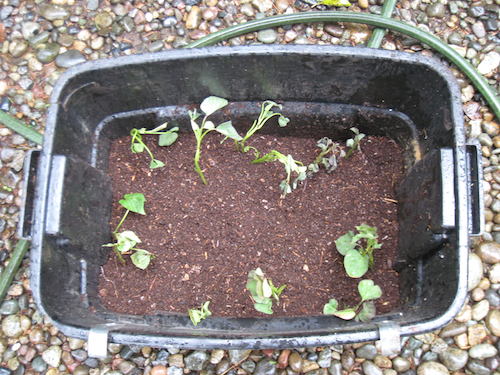
production sweet potatoes, April 28 2010 photo by ALJ
|
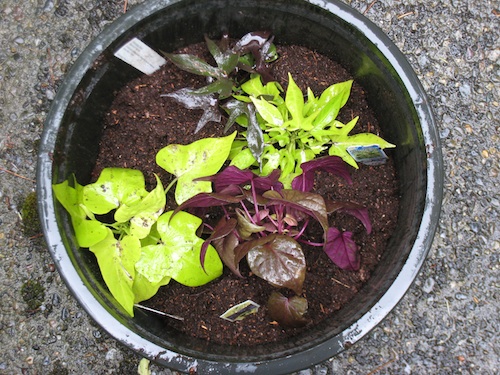
ornamental sweet potatoes, April 28 2010 photo by ALJ
|
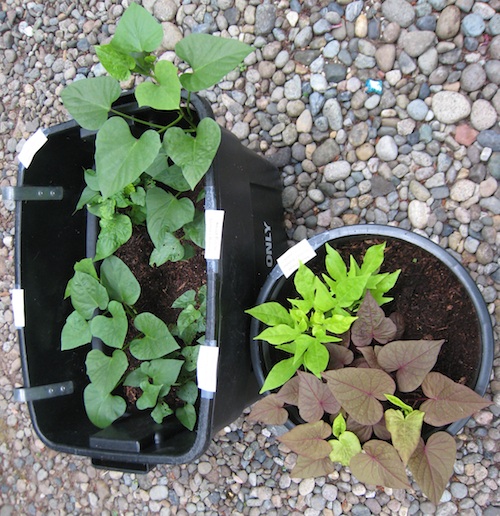
sweet potatoes, Aug 2 2010 photo by ALJ
|
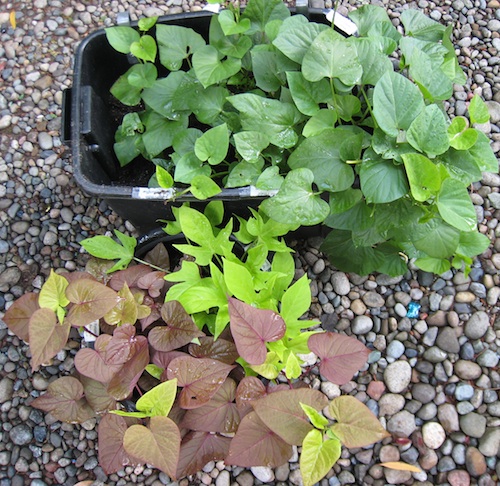
sweet potatoes, Sept 1 2010 photo by ALJ
|
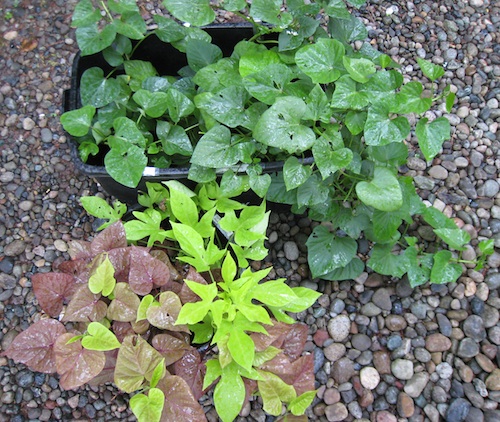
sweet potatoes, Sept 18 2008 photo by ALJ
|
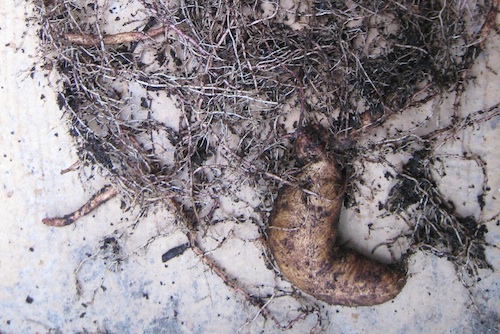
Beauregard sweet potato, Nov 6 2010 photo by ALJ
|
|







